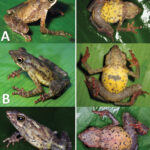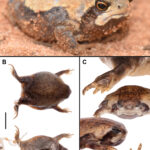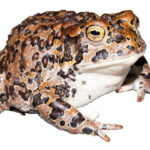- Introduction: Discovering the Harlequin Frog of Mindo
- Taxonomy and Classification
- Natural Habitat: Life Among the Clouds
- Physical Characteristics — The Artistry of Nature’s Palette
- Behavior and Life Cycle: Songs of Forest Streams and Ballet of Breeding
- Ecological Role: More Than a Bright Splash of Color
- Threats and Conservation Status: Fighting on the Front Lines
- Cultural and Scientific Significance: Symbols and Science Interwoven
- Conclusion: Guardians of Ecuador’s Precious Cloud Forests
Introduction: Discovering the Harlequin Frog of Mindo#
Tucked away within the lush cloud forests of northwestern Ecuador, where mist gently drapes the dense greenery and vibrant orchids illuminate ancient tree trunks, dwells an amphibian of extraordinary beauty and resilience. Its scientific name is Atelopus mindoensis, commonly known as the Mindo Harlequin Frog, a visually captivating creature whose brightly patterned skin has both enchanted and challenged generations of naturalists. This small yet remarkable amphibian isn’t merely ornamentation within its ecosystem—it stands as a powerful symbol of biodiversity’s delicate balance and a living testimony to ongoing conservation battles.
Named after the small village of Mindo—famous for its biological exuberance—the Mindo harlequin frog is a poignant reminder of nature’s fragility and resilience. Sometimes whimsically referred to by naturalists as “the living jewels of Ecuador,” harlequin frogs hold cultural, scientific, and environmental importance, catching glimpses and garnering admiration from all who encounter them.
Taxonomy and Classification#
Belonging to the vibrant and charismatic Bufonidae family of amphibians (the true toads), Atelopus mindoensis occupies an intriguing taxonomy filled with colorful cousins. Within its genus, Atelopus, this species shares kinship with dozens of similarly striking harlequin frogs scattered from Costa Rica through South America. Their characteristic bright colors often serve as visual warnings to would-be predators, signaling toxins harbored within the frogs’ skin glands.
First described scientifically in the 1970s, this species epitomizes the genus’ hallmark features—a relatively small frame, striking patterns, and vibrant palette that captivated early researchers and collectors. Unlike more mundane amphibians, Atelopus mindoensis leads with its magnificent appearance, actively engaging imaginations and sparking ecological dialogue wherever it is found.
Natural Habitat: Life Among the Clouds#
A Haven in the Mindo Cloud Forest#
Atelopus mindoensis is endemic exclusively to Ecuador, primarily concentrated in the lush montane cloud forests near the town of Mindo—an ecological haven celebrated globally for its staggering biodiversity. Situated on the western slopes of the Andes mountains, this region receives abundant rainfall year-round. Constant precipitation, mild temperatures, and pervasive mist allow luxuriant vegetation to flourish, creating a colony of vibrant life from forest floor to canopy.
Harlequin frogs, particularly Atelopus mindoensis, carefully choose habitats near pristine freshwater streams and gentle waterfalls. These amphibians exhibit affinity for humid, shaded environments, spending their days nestled near moss-covered rocks or leaf litter adjacent to rushing waterlogged ravines. The forest canopy filters sunlight delicately, casting dappled patterns that camouflage these frogs among fallen leaves and vividly colored fungi, an elegant dance of disguise and revelation.
Delicate Dependence on Pristine Streams#
Water quality critically influences the presence and survival of these frogs, emphasizing their specialized ecological role. The delicate, jelly-like eggs and developing tadpoles depend entirely on clean, oxygen-rich streams. Their permeable skins easily absorb pollutants or toxins—proof of nature’s intricate design yet also a stark vulnerability which has recently threatened the species’ very existence.
Physical Characteristics — The Artistry of Nature’s Palette#
Mindo’s harlequin frog is relatively small, typically measuring mere centimeters from snout to vent. However, size belies significance, as one glance at its vibrant coloration confirms immediately its extraordinary presence. The body bears intricate bright yellow or lime-green markings artistically splashed onto a dark brown or black canvas. Some individuals exhibit stark silvery-white bands, intensifying the visual contrast and creating a stunning mosaic that warrants photographers’ admiration.
Such conspicuous coloration serves as aposematic signaling—environmental messaging which communicates clearly to predators that the frogs harbor potent toxins. Within their small bodies, specialized skin glands secrete substances distasteful or toxic to predators, warding off threats and ensuring survival amidst a biodiversity-rich habitat filled with potential danger.
The stark, vivid colors also aid in individual identification among frogs, greatly facilitating social behavior and mate identification amid dense vegetation and shadowy, misty habitats. Indeed, their captivating looks function as both deterrence and attraction, balancing survival necessities deftly between ecological pressure and reproductive imperatives.
Behavior and Life Cycle: Songs of Forest Streams and Ballet of Breeding#
Feeding Strategy and Ecological Navigation#
Atelopus mindoensis exhibits a daytime (diurnal) pattern of activity, engaging energetically in feeding during morning and late afternoon abundance. Their diet predominantly comprises small insects, arachnids, and other invertebrates abundant within mossy, leafy environments. Positioned strategically near the moist forest floor or stream banks, they employ ambush-style hunting techniques, relying on patient stillness followed by swift and precise movements as prey ventures within range.
Dance of Courtship and Parentage#
The rainy season brings heightened activity among the frogs, leading to fascinating courtship performances. Males congregate near water sources, creating synchronized choruses consisting of subtle, chirping trill-calls to attract the attention of receptive females. Competition among males is not uncommon, with disputes manifesting in strategic vocalizations and positional play rather than physical aggression.
Once pairs form, spawning occurs within clear, shallow sections of flowing streams. Females deposit gelatinous egg masses attached delicately to submerged rocks or vegetation. The eggs gently sway and absorb oxygen provided by the stream’s perpetual movement, facilitating successful early developmental stages.
Tadpoles—The Sensitive Youth#
Tadpole development unfolds slowly, and these juvenile frogs spend considerable time in their aquatic nursery environments, carefully anchored to rocks or gravel beds by specialized oral discs. Survival demands clear, flowing water; even minimal degradation of stream quality places their fragile life cycle at risk. This truth again reminds us how sensitive Atelopus mindoensis truly is, intimately bound to ecological integrity.
Ecological Role: More Than a Bright Splash of Color#
Beyond aesthetic fascination, this amphibian occupies a pivotal ecological niche as both predator and prey. As a vital predator of insects and other small invertebrates, harlequin frogs help balance populations of potential pest species, maintaining forest ecosystem stability. Concomitantly, they supply nourishment for predators, primarily snakes and birds, contributing broadly to complex forest interdependence.
Critically, amphibians such as Atelopus mindoensis are acknowledged as “bioindicators.” Their thin, permeable skin makes them highly sensitive to environmental alterations including pollutants, habitat destruction, and climatic change—essentially signaling distress within ecosystems long before more robust species display warning signs.
Threats and Conservation Status: Fighting on the Front Lines#
Sadly, despite their vivid beauty and ecological importance, Atelopus mindoensis populations continue to decline sharply, mirroring global amphibian crises. The International Union for Conservation of Nature (IUCN) currently classifies them as Critically Endangered, confronting dire threats like habitat loss, habitat degradation through agriculture expansion and tourism, and—tragically—the spread of the devastating chytrid fungus.
Chytrid Fungus: A Deadly Pandemic for Amphibians#
Perhaps most troubling among threats is chytridiomycosis—a lethal fungal disease relentlessly impacting frog populations worldwide. Researchers in Ecuador have documented alarming declines precipitated by this pathogenic fungus, and urgent collective conservation response is now indisputably necessary.
Conservation Action on the Ground#
Thankfully, targeted conservation measures are underway. Local and international initiatives aim to safeguard remaining habitat, establish captive breeding programs, and support further scientific research. Educating local communities and visitors to the forest about conservation practice has been key, invigorating grassroots conservation efforts and highlighting sustainable coexistence between people and wildlife.
Cultural and Scientific Significance: Symbols and Science Interwoven#
Historically, amphibians across Latin America hold rich symbolic roles in local folklore and culture, often representing indicators of environmental health. Scientifically, researchers continuously study the toxins produced by frogs like Atelopus mindoensis in biomedical laboratories—promising potentially groundbreaking therapeutic applications. Their value far transcends mere beauty, representing a trove of knowledge waiting to be unveiled.
Conclusion: Guardians of Ecuador’s Precious Cloud Forests#
Atelopus mindoensis encapsulates a vibrant, glorious symbol of nature’s beauty intertwined with vulnerability. As ambassadors of pristine mountain streams and guardians of biodiversity, their survival is intrinsically linked to our collective ecological responsibility. Awareness, appreciation, and active involvement in conservation can make a tangible difference. Every reader, every nature lover, conservation advocate, or curious student holds within themselves the power to contribute positively—to ensure the Mindo harlequin frog persists, colorful, healthy, and thriving amid the emerald veil of Ecuador’s magnificent cloud forests.







